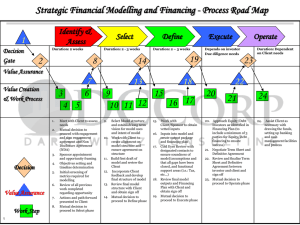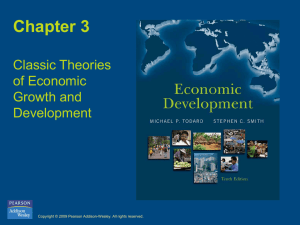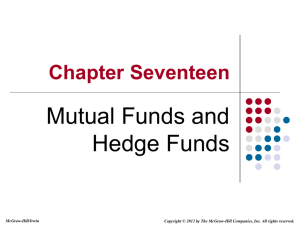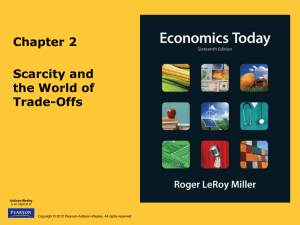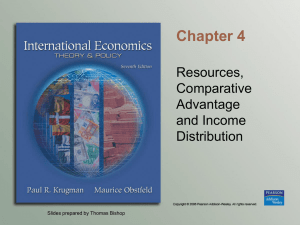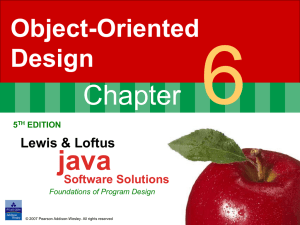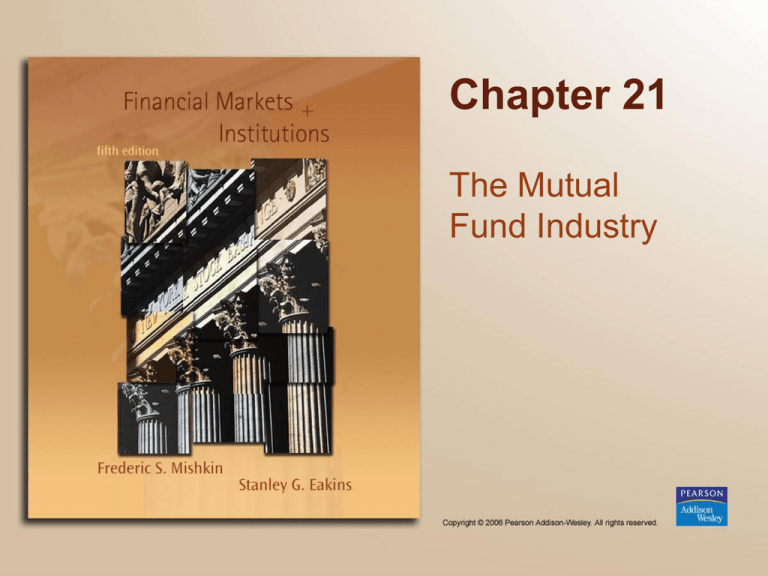
Chapter 21
The Mutual
Fund Industry
Chapter Preview
• We study why mutual funds have become
so popular, the various types of mutual
funds, their regulation, and scandals in the
mutual fund industry. Topics include:
– The Growth of Mutual Funds
– Mutual Fund Structure
– Investment Objective Classes
– Fee Structure of Investment Funds
Copyright © 2006 Pearson Addison-Wesley. All rights reserved.
21-2
Chapter Preview (cont.)
– Regulation of Mutual Funds
– Hedge Funds
– Conflicts of Interest in the Mutual
Fund Industry
Copyright © 2006 Pearson Addison-Wesley. All rights reserved.
21-3
Mutual Funds
• Mutual funds pool the resources of many
small investors by selling them shares and
using the proceeds to buy securities.
Copyright © 2006 Pearson Addison-Wesley. All rights reserved.
21-4
The Growth of Mutual Funds
• At the beginning of 2004, nearly 16% of
assets held by intermediaries were held by
mutual funds.
• 22% of the retirement market and almost
50% of all U.S. households hold stock via
mutual funds.
• Assets held by mutual funds have grown by
over 17.5% per year for the last 20 years,
reaching $7.4 trillion in 2004.
Copyright © 2006 Pearson Addison-Wesley. All rights reserved.
21-5
The Growth of Mutual Funds
• The first mutual fund similar to the funds of
today was introduced in Boston in 1824.
• The stock market crash of 1929 set the
mutual fund industry back because small
investors avoid stocks and distrusted
mutual funds.
• The Investment Company Act of 1940
reinvigorated the industry by requiring
better disclosure of fees, etc.
Copyright © 2006 Pearson Addison-Wesley. All rights reserved.
21-6
The Growth of Mutual Funds
•
There are five principal benefits of mutual funds:
1. Liquidity intermediation: investors can quickly convert
investments into cash while still allowing the fund to
invest for the long term.
2. Denomination intermediation: investors can
participate in equity and debt offerings that,
individually, require more capital than they possess.
3. Diversification: investors immediately realize the
benefits of diversification even for small investments.
Copyright © 2006 Pearson Addison-Wesley. All rights reserved.
21-7
The Growth of Mutual Funds
• There are five principal benefits of
mutual funds:
4. Cost advantages: the mutual fund can
negotiate lower transaction fees than would
be available to the individual investor.
5. Managerial expertise: many investors prefer
to rely on professional money managers to
select their investments.
Copyright © 2006 Pearson Addison-Wesley. All rights reserved.
21-8
The Growth of Mutual Funds
•
Ownership in mutual funds has changed
dramatically over the last 20 years
– In 1980, only 5.7% of households held mutual
fund shares
– In the beginning of 2004, that number was 48%
– Mutual funds account for $2.7 trillion of the retirement
market (estimated at $12 trillion)
•
The next three slides show the time series of
these trends.
Copyright © 2006 Pearson Addison-Wesley. All rights reserved.
21-9
The Growth of Mutual Funds
The Growth of Mutual Funds (cont.)
The Growth of Mutual Funds
Figure 21.1 Household Ownership of Mutual Funds, 1980-2003
Copyright © 2006 Pearson Addison-Wesley. All rights reserved.
21-12
The Growth of Mutual Funds
Figure 21.2 Average Asset Allocation for All 401(k) Plan Balances
Copyright © 2006 Pearson Addison-Wesley. All rights reserved.
21-13
Mutual Fund Structure
• Investment companies usually offer a
number of different types of mutual funds.
• Investors can often move investments
among these funds without penalty.
• The complexes often issue
consolidated statements.
Copyright © 2006 Pearson Addison-Wesley. All rights reserved.
Mutual fund fact book
http://www.ici.org/aboutfunds/factbook_toc.html
21-14
Mutual Fund Structure
• Closed-End Fund: a fixed number of
nonredeemable shares are sold through an
initial offering and are then traded in the
OTC market. Price for the shares is
determined by supply and demand forces.
• Open-End Fund: investors may buy or
redeem shares at any point, where the
price is determined by the net asset value
of the fund.
Copyright © 2006 Pearson Addison-Wesley. All rights reserved.
21-15
Calculating a Mutual Fund’s
Net Asset Value
• Net Asset Value (NAV)
• Definition: Total value of the mutual fund’s stocks,
bonds, cash, and other assets minus any liabilities
such as accrued fees, divided by the number of
shares outstanding
Stocks
Bonds
Cash
Total value of assets
Liabilities
Net worth
Outstanding shares
$35,000,000
$15,000,000
$3,000,000
$53,000,000
-$800,000
$52,200,000
15 million
NAV = $52,200,000 /15,000,000 = $3.48
Copyright © 2006 Pearson Addison-Wesley. All rights reserved.
21-16
Mutual Fund Structure:
the Organization
• The shareholders, or owners, of the mutual
fund are the investors.
• The board of directors oversees the fund’s
activities, hires the investment advisor, an
underwriter, etc., to manage the day to day
operations of the fund.
Copyright © 2006 Pearson Addison-Wesley. All rights reserved.
21-17
Mutual Fund Structure:
the Organization
Figure 21.3 The Organizational Structure of a Mutual Fund
Copyright © 2006 Pearson Addison-Wesley. All rights reserved.
21-18
Mutual Fund Structure:
the Organization
• In theory, the board can fire the fund manager
and hire anyone they choose. For instance, the
board for the Fidelity Magellan Fund can fire
Fidelity. Of course, if the board hires a nonFidelity management team, the fund will probably
lose its name, and its reputation along with it.
Copyright © 2006 Pearson Addison-Wesley. All rights reserved.
21-19
Investment Objective Classes
• There are four primary classes of mutual
funds available to investors:
1. Stock (equity) funds
2. Bond funds
3. Hybrid funds
4. Money market funds
• The next slide shows the distribution of
assets among these different classes.
Copyright © 2006 Pearson Addison-Wesley. All rights reserved.
21-20
Investment Objective Classes
Figure 21.4 Distribution of Assets Among Types of Mutual Fund, 2004
Copyright © 2006 Pearson Addison-Wesley. All rights reserved.
21-21
Investment Objective Classes
•
Stock Funds
– Other than investing in common equity, the stated
objective of any particular fund can vary dramatically.
– Capital Appreciation Funds seek rapid increase in
share price, not being concerned about dividends.
– Total Return Funds seek a balance of current income
and capital appreciation.
– World Equity Funds invest primarily in foreign firms.
– Other types in Value, Growth, a particular
industry, etc.
Copyright © 2006 Pearson Addison-Wesley. All rights reserved.
21-22
Investment Objective Classes
•
Bond Funds
– Strategic Income Funds invest primarily in U.S.
corporate bonds, seeking a high level of
current income.
– Government Bond Funds invest in U.S. Treasury, as
well as state and local government bonds.
– Others include World Bond Funds, etc.
•
The next figure shows the distribution of assets
among the bond fund classifications.
Copyright © 2006 Pearson Addison-Wesley. All rights reserved.
21-23
Investment Objective Classes
Figure 21.5 Assets Invested in Different Types of Bond Mutual Funds
Copyright © 2006 Pearson Addison-Wesley. All rights reserved.
21-24
Investment Objective Classes
• Hybrid Funds
– Combine stocks and bonds into a single fund.
– Account for about 7% of all mutual
fund accounts.
Copyright © 2006 Pearson Addison-Wesley. All rights reserved.
21-25
Investment Objective Classes
• Money Market Mutual Funds
– Open-end funds that invest only in money
market securities.
– Offer check-writing privileges.
– Net assets have grown dramatically, as seen
in the next slide.
Copyright © 2006 Pearson Addison-Wesley. All rights reserved.
21-26
Investment Objective Classes
Figure 21.6 Net Assets of Money Market Mutual Funds, 1975-2003
Copyright © 2006 Pearson Addison-Wesley. All rights reserved.
21-27
Investment Objective Classes
• Money Market Mutual Funds
– Although money market mutual funds offer
higher returns than bank deposits, the funds
are not federally insured.
– The next slide shows the distribution of assets
in MMMF, which are relatively safe assets.
Copyright © 2006 Pearson Addison-Wesley. All rights reserved.
21-28
Investment Objective Classes
Figure 21.7 Average Distribution of Money Market Fund Assets, 2004
Copyright © 2006 Pearson Addison-Wesley. All rights reserved.
21-29
Investment Objective Classes
• Index Funds
– A special class of mutual funds that do fit into
any of the categories discussed so far.
– The fund contains the stock of the index it is
mimicking. For example, an S&P 500 index
fund would hold the equities comprising the
S&P 500.
– Offers benefits of traditional mutual funds
without the fees of the professional
money manager.
Copyright © 2006 Pearson Addison-Wesley. All rights reserved.
21-30
Fee Structure of Investment Funds
• Load funds (class A shares) charge an upfront
fee for buying the shares. No-load funds do not
charge this fee.
• Deferred load (class B shares) funds charge a
fee when the shares are redeemed.
• If the particular fund charges no front or back end
fees, it is referred to as class C shares.
Copyright © 2006 Pearson Addison-Wesley. All rights reserved.
21-31
Fee Structure of Investment Funds
• Other fees charges by mutual funds include:
– contingent deferred sales charge: a back end fee that
may disappear altogether after a specific period.
– redemption fee: another name for a back end load
– exchange fee: a fee (usually low) for transferring
money between funds in the same family.
– account maintenance fee: charges if the account
balance is too low.
– 12b-1 fee: fee to pay marketing, advertising,
and commissions.
Copyright © 2006 Pearson Addison-Wesley. All rights reserved.
21-32
Regulation of Mutual Funds
• Mutual funds are regulated by four primary laws:
– Securities Act of 1933: specifies
disclosure requirements
– Securities Exchange Act of 1934: details
antifraud rules
– Investment Company Act of 1940: requires registration
and minimal operating standards
– Investment Advisors Act of 1940: regulates
fund advisors
Copyright © 2006 Pearson Addison-Wesley. All rights reserved.
21-33
Regulation of Mutual Funds
• Mutual funds are the only companies in the U.S.
that are required by law to have independent
directors, as follows (2001 SEC rules)
– Independent directors must constitute a majority of
the board
– Independent directors select and nominate other
independent directors
– Legal counsel to the independent directors must also
be independent
Copyright © 2006 Pearson Addison-Wesley. All rights reserved.
21-34
Hedge Funds
• A special type of mutual fund that received
considerable attention following the collapse of
Long Term Capital Management.
• Different from typical mutual funds, as follows:
– High minimum investment, averaging around $1 million
– Long-term commitment of funds is required
– High fees: typically 1% of assets plus 20% of profits
– Highly levered
– Little current regulation
Copyright © 2006 Pearson Addison-Wesley. All rights reserved.
21-35
Hedge Funds
• Hedge funds are often trying to take advantage of
unusual spreads between security prices
Figure 21.8 The Price of Two Similar Securities
Copyright © 2006 Pearson Addison-Wesley. All rights reserved.
21-36
Conflicts of Interest
in the Mutual Fund Industry
• Investor confidence in the stability and
integrity of the mutual fund industry
is critical.
• However, the usual problems of
asymmetric information and the principalagent problem arose, leading to abuses on
the part of fund management.
Copyright © 2006 Pearson Addison-Wesley. All rights reserved.
21-37
Conflicts of Interest
in the Mutual Fund Industry
• Mutual Fund Abuses
– Late trading: allowing trades after 4:00 pm to
trade at today’s 4:00 NAV instead of
tomorrow’s price. This is illegal under
SEC regulations.
– Market timing: taking advantage of time zone
differences for determination of NAV. This is
not illegal under SEC rulings.
Copyright © 2006 Pearson Addison-Wesley. All rights reserved.
21-38
Conflicts of Interest
in the Mutual Fund Industry
• Government Response to Abuses
– Require more independent directors
– Hardening the 4:00 valuation rule: this addresses the
late trading problem, but not market timing.
– Increased and enforces redemption fees: fees to
discourage market timing by additional fees for shortterm redemptions.
– Increased transparency: hits operating practices,
directors, investment managers, compensation
arrangements with brokers, etc.
Copyright © 2006 Pearson Addison-Wesley. All rights reserved.
21-39

